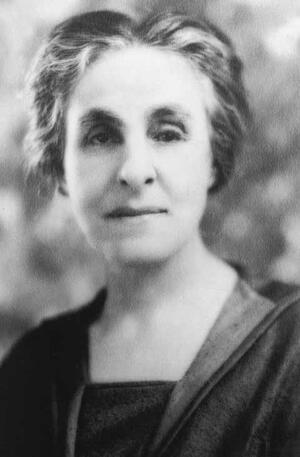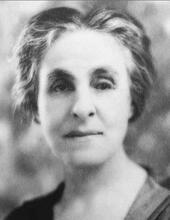Ray Frank
Ray Frank began her career as a journalist but shifted to being a preacher at Jewish congregations in 1890. She quickly became a prominent figure in the Jewish community and gave an address at the first Jewish Women’s Congress in 1893. She was the first Jewish woman to preach from a pulpit in the United States, and her speeches often encouraged communal cooperation and tried to heal congregational disputes. After her marriage in 1910, she retired from preaching and became the wife of a college professor. She continued her participation in Jewish organizations, although on a much smaller scale, until the end of her life.
On the evening of The Day of Atonement, which falls on the 10th day of the Hebrew month of Tishrei and is devoted to prayer and fasting.Yom Kippur in 1890, a tall, serious-looking young woman named Ray Frank stood before hundreds of men and women in the Opera House of Spokane Falls, Washington. Invited to deliver the sermon at a religious service that she herself had initiated, she implored those Jews in attendance to “drop all dissension about whether you should take off your hats during the service and other unimportant ceremonials and join hands in one glorious cause.” With these words, the twenty-nine-year-old journalist from Oakland, California, helped create the first Jewish congregation in Spokane Falls and began her career as a Jewish religious leader.
Early Life
Born in San Francisco on April 10, 1861 (some records give 1864 or 1865 as her year of birth), to Bernard Frank, a peddler and fruit vendor, and his wife Leah, Ray Frank and her two sisters were raised in what she later described as a deeply religious home. Her mother was a quiet, pious woman, who was fond of reading the Bible, while her father, an Orthodox Jew, was a great-grandson of Rabbi Elijah ben Solomon, the renowned Head of the Torah academies of Sura and Pumbedita in 6th to 11th c. Babylonia.gaon of Vilna.
Primarily raised in San Francisco, where she attended public school, Frank graduated in 1879 from Sacramento High School and moved to Ruby Hill, Nevada, where she taught for six years. In 1885, she rejoined her family, which by then had moved to Oakland, California. To support herself, she offered private literature and elocution lessons and began to write for several periodicals. She also taught Sabbath school classes at First Hebrew Congregation and subsequently become superintendent of its religious school.
During the 1890s, she earned additional income as correspondent for several Oakland and San Francisco newspapers. Based in Oakland, she traveled throughout the Pacific Northwest. In September 1890, she arrived in Spokane, Washington (then known as Spokane Falls), on the evening of The Jewish New Year, held on the first and second days of the Hebrew month of Tishrei. Referred to alternatively as the "Day of Judgement" and the "Day of Blowing" (of the shofar).Rosh Ha-Shanah. Inquiring where she might find a local synagogue, she discovered that there was neither a synagogue nor planned religious services, as the Jewish community was small and torn apart by religious dissension. Procuring the help of a local man to whom she had a letter of introduction, Frank offered to deliver the sermon that evening if a The quorum, traditionally of ten adult males over the age of thirteen, required for public synagogue service and several other religious ceremonies.minyan [prayer quorum] could be gathered.
Career
By five o’clock, a special edition of the Spokane Falls Gazette announced that a young woman would be preaching to the Jews of the community at the Opera House that night. According to local newspaper reports, one thousand Jews and Christians were in attendance when Ray Frank spoke about the obligations of Jews as Jews and as citizens. Moved by her plea that her coreligionists come together and create a congregation, a Christian man in attendance stood up and offered to donate a site on which the synagogue might be built.
After she preached the next morning and again on Yom Kippur, Frank’s call for communal cooperation was so successful that she repeated these efforts elsewhere. While continuing to support herself as a journalist, she preached and lectured widely throughout the western and northwestern United States, healing congregational squabbles and helping to create both Orthodox and Reform congregations. Hailed by local newspapers as a “latter-day Deborah,” referring to the biblical judge and religious leader, and erroneously labeled a “Lady Rabbi,” she came to the attention of Reform rabbi Isaac Mayer Wise, president of Hebrew Union College (HUC), the rabbinical seminary that he had founded a decade earlier in Cincinnati.
Enrolling at HUC in January of 1893 for what proved to be only one semester, Frank told the press that her intention was to study Jewish philosophy, not to become a rabbi. Yet less than two months earlier, in his own American Israelite, Wise wrote that “we glory in her zeal and moral courage to break down the last remains of the barriers erected in the synagogue against women and wish her the best of success.” Subsequently, in February of 1893, the American Israelite identified Frank as the “young lady who has gained much prestige on the Pacific Coast and whose avowed purpose of entering the Jewish ministry has aroused much attention.”
Her reputation as a preacher grew, and in September 1893 she delivered the opening prayer and a formal address on “Woman in the Synagogue” at the first Jewish Women’s Congress held in conjunction with the Parliament of World Religions at the Chicago World’s Fair. After speaking at synagogues and churches throughout North America, even officiating in 1895 for High Holy Day services at an Orthodox synagogue in Victoria, British Columbia, she declined the invitation of a Reform congregation in Chicago to become its full-time spiritual leader, believing that she could do her best work “unfettered by boards of trustees and salary stipulations.”
Later Life
Frank’s dual career as journalist and preacher ended after her marriage to Dr. Simon Litman in August 1901. He taught economics for the next seven years at the University of California, Berkeley, and then accepted a teaching position at the University of Illinois, Champaign-Urbana. As early as 1915, Frank organized and led at her home an ongoing student study circle on postbiblical Jewish history. Actively involved in local Jewish organizations and institutions, including the Reform congregation to which she belonged, she occasionally lectured in the community and throughout the Midwest. Ray Frank died in a private sanatorium in Peoria, Illinois, in October of 1948 and was buried in Urbana.
While her career was short-lived, Ray Frank remains significant as the first Jewish woman to preach from a pulpit in the United States, and the first to be seen as a Jewish religious leader.
Clar, Reva, and William M. Kramer. “The Girl Rabbi of the Golden West.” Western States Jewish History 18 (1986): 91–111, 223–236, 336–351.
Frank, Ray. Papers, correspondence and scrapbooks highlighting her preaching career, American Jewish Historical Society, Waltham, Mass.
Litman, Simon. Ray Frank Litman: A Memoir (1957).
Nadell, Pamela Susan. Women Who Would be Rabbis: Q History of Women's Ordination 1889-1985. Boston: Beacon Press, 1999.




